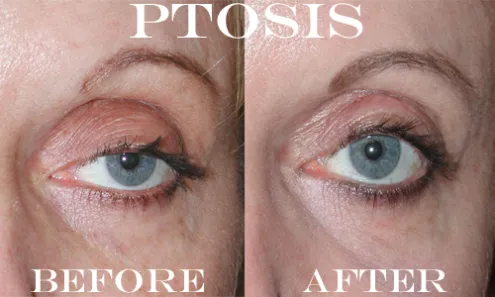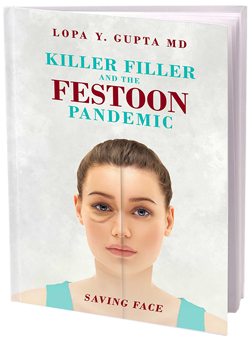Dr. Gupta began her practice in 1997 with the desire and foresight to abandon scalpel surgery to offer her patients cutting-edge technology for optimal safety and precision. She worked tirelessly to fine-tune laser and radiowave surgery to perform all eyelid and facial cosmetic procedures in a soothing office atmosphere under local anesthesia—no need to go to the hospital or to go under general anesthesia! Now in her 26th year of practice, Dr. Gupta has become internationally recognized for her novel festoon surgery technique and artistic laser blepharoplasty. She has also become proficient in mini incision SMAS face lifting and laser liposculpture. Briefly, a laser utilizes a focused beam of monochromatic light while radio waves employ high frequency energy to incise, dissect, and excise tissues.
Surgical Procedures
Both offer the following distinct advantages:
- Optimal control of bleeding from simultaneous cauterization of blood vessels
- Safer surgery with more precision and artistry
- Minimal collateral heat spread, destruction, and scarring of adjacent tissues
- Faster recovery with less down time, pain, bruising, swelling, and scarring
- Ability to perform procedures in office under local

No-Scalpel Blepharoplasty, Xanthelasma Excision with Plastic Surgery Repair, Ptosis Surgery
EYELID CONDITION: DERMATOCHALASIS
Loss of elasticity and structural support in the upper and lower eyelids as a result of gravity, genetics, age, daily habits, and environmental insults (sun, allergies, pollution). Skin looks saggy, crepey, hooded, and wrinkled. Fat pads prolapse resulting in bags.
Surgery
Blepharoplasty is performed to remove the excess skin and fat from the upper and/or lower eyelids. While it may seem simple, this is one of the most difficult procedures (especially lower blepharoplasty with skin excision) to perform on the face. This is because of the intricate relationship of eyelid fat to the optic nerve and vision, the risk of ectropion (lower lid hangs down) from aggressive skin removal, and the potential for dry eye sequelae. The eyes are an extension of the brain and there is no room for error when it comes to eyelid surgery! “Bad eyelid surgery” can be devastating for patients and can lead to aesthetic, functional, and psychological impairment for the patient. Unfortunately, I do perform numerous revision blepharoplasties every year on patients who have had unsatisfactory outcomes elsewhere.
EYELID SURGERY: PTOSIS
Blepharoptosis or Eyelid Ptosis results primarily from weakening of the tendon (aponeurosis) that attaches the levator muscle in our eyelid to the tarsal plate, the supporting structure at the lid margin. This results in a muscle droop and the eyelid can appear partially closed. The most common causes of ptosis include age-related, trauma, and chronic contact lens wear. Neurologic causes (myasthenia gravis, Horner’s syndrome, CPEO) tend to be less common but need to be ruled out.
Surgery:
The success of ptosis surgery depends on the function of the underlying levator muscle—despite the condition of the tendon. If the function is adequate but the ptosis is severe, then repair must be performed with an external incision whereby the tendon is advanced to lift the lid. If the ptosis is mild, an alternative route may be employed whereby the incision is on the inside of the lid and another muscle that lifts the eyelid (Muller’s muscle) is strengthened.

EYELID CONDITION: XANTHELASMA
Xanthelasma are cholesterol plaques that are likely deposited through the circulation to the inner third of the upper and lower eyelids. Since 50% of patients have hypercholesterolemia, I always recommend a serum lipid profile test and cholesterol treatment if indicated. The plaques are yellowish in color and impossible to conceal with makeup. They have the potential to grow over time and if left untreated, can cover most
of the eyelid. Other than adverse effects on cosmesis and mental health, there is no malignant potential. Plaques that are removed completely do not recur but new ones may be deposited.
Surgery
In most instances, xanthelasma excision is coupled with upper and/or lower blepharoplasty. When an extensive plaque has been removed and there is a large tissue defect, I often use normal skin excised from the blepharoplasty to repair the defect. This can be a free full thickness skin graft or a swinging pedicle flap. When this is not possible, I obtain a skin graft from behind the ear. All sutures I utilize are self-dissolving.
Festoons
Festoons are unsightly bulges located in the prezygomatic space (PZS) of the midface at the junction of the lower eyelid and cheek. Numerous monikers exist, including cheek mounds, cheek bags, malar mounds, malar edema, and double bags. Fluid pools in this area because there is a lot of “dead space” like a sponge and because there is a tight ligament that prevents excess fluid from draining down the cheek.
Here are common festoon triggers promoting fluid buildup in the PZS:
- Hyaluronic acid (HA) fillers like Juvederm, Voluma, Restylane injected in the lower lids or cheeks are the LEADING CAUSE OF FESTOONS TODAY. HA fillers are hydrophilic and love water. HA fillers NEVER GO AWAY completely—there is almostalways a trapped residual that can wreak havoc by dr awing water, especially after a salty meal, alcohol, or high altitudes. Even a single injection done 10-15 years prior can linger and cause swelling issues for a life time.
- Autologous fat grafts injected into the lower eyelids and/or midface with or without a face lift. The survival of fat requires ingrowth of a capillary bed which can become leaky, adding fluid to the PZS. Moreover, if the patient gains weight in the donor area from where the fat was harvested, this will cause swelling of the injected fat in the face with additional leakage into the PZS.
- Sinus/nasal disease or obstruction can cause increased mucus buildup, leading to backup in the lower eyelids, upper eyelids, and PZS with resultant lid edema and festoons.
- Allergies cause inflammation, leading to increased fluid in the eyelids and PZS
- Sun damage can lead to loss of elasticity of the skin as well as chronic inflammation which can add fluid to the malar region
- Lymphatic damage from aggressive eyelid, face lift, or midface lift surgeries

Surgery:
My technique, MIDFACE, has resulted in excellent long-term resolution of festoons over the
past 15 years. It entails a slit-like incision hidden in a natural crease at the bottom of the lower
eyelid. Through this opening, the five-layered festoon area, which is a like a supersaturated
sponge, is completely desiccated and tightened from the deep fat (SOOF) to the superficial malar fat pad. Some loose skin and muscle are excised to enhance the result. If HA filler is causing the festoon, it is dissolved with enzyme preoperatively and any residual destroyed during surgery. If injected, autologous fat or another non-HA filler is causing the festoon, it is meticulously dissected free from all adjacent tissues and completely removed from the lower lid and malar regions. This process is extremely tedious and often takes several hours. It is usually combined with a lower blepharoplasty for optimal fat/filler/loose skin removal.
Mini SMAS face lifts
To address early or moderate laxity of the lower face and jowls, I perform mini SMAS face lifts to tighten the superficial muscle called the SMAS and to excise loose, redundant skin. The incision is hidden in the temporal hairline, in front of the ear, and behind the ear. The procedure is performed with a combination of local anesthetic given to the incision site and tumescent anesthesia (saline with a dilute mixture of lidocaine, bicarbonate, and epinephrine) to the rest of the face where the lifting will occur. Because major facial vessels and nerves are located deep to the SMAS, these mini lifts are not predisposed to nerve injury or major bleeding. Great caution, nonetheless, is exercised using laser or radio surgery to obtain optimal bleeding control throughout. The muscle plication sutures dissolve over 6-9 months while the skin closure sutures dissolve in 2-3 weeks. Proper stitching is ensured to prevent a pixie ear deformity whereby the skin of the ear is pulled down into the incision with loss of the earlobe contour. Recovery tends to be fairly rapid for most patients with the typical down time being 1-2 weeks.
Laser Liposculpture
To address small problem areas that are resistant to diet and exercise, I perform small volume (-500 cc) laser liposculpture. It is performed with tumescent anesthesia. The laser melts the fat for easier aspiration with a cannula. The laser also stimulates collagen production to help tighten and retract the skin after fat removal. Popular areas include fat under the chin and jawline, triceps region, above the knee, saddle bags, around the belly button (periumbilical), and under the buttocks (subgluteal). A compression garment is worn part time for up to 6 weeks to minimize bruising and to optimize contouring. While most patients do not experience pain, the operated area may feel sore for a week or so. Average down time is 1 week.
Earlobe Surgery
After years of adorning our faces with heavy earrings, our earring holes can get stretched out and some lose expensive diamond studs as a result. To correct elongated earring holes, the area is first numbed with local anesthetic. The epithelium of the earring hole is then denuded followed by a multilayered deep and skin sutures to close the defect. In select cases where only light studs would be worn, I leave the top part of the hole open for immediate use.
As we age, our earlobes lose volume and elasticity resulting in unattractive lobes that have a saggy, creased look. Earlobe rejuvenation can take years off the face by surgical removal of the excess tissue with fillers to enhance sculpture and volume for a more youthful look. The procedure is readily performed in the office under local and all sutures are self-dissolving. Downtime is minimal and earrings can be worn in just a few days.
FAQ's for Surgical Procedures
Eyelid/Festoon/Facial Procedures FAQ's and Answers. The Q & A is intended to provide you with a general overview of what to expect with my procedures. Should you have any further questions, kindly contact our offices at (212) 203-2838 or (914) 997-2646.

